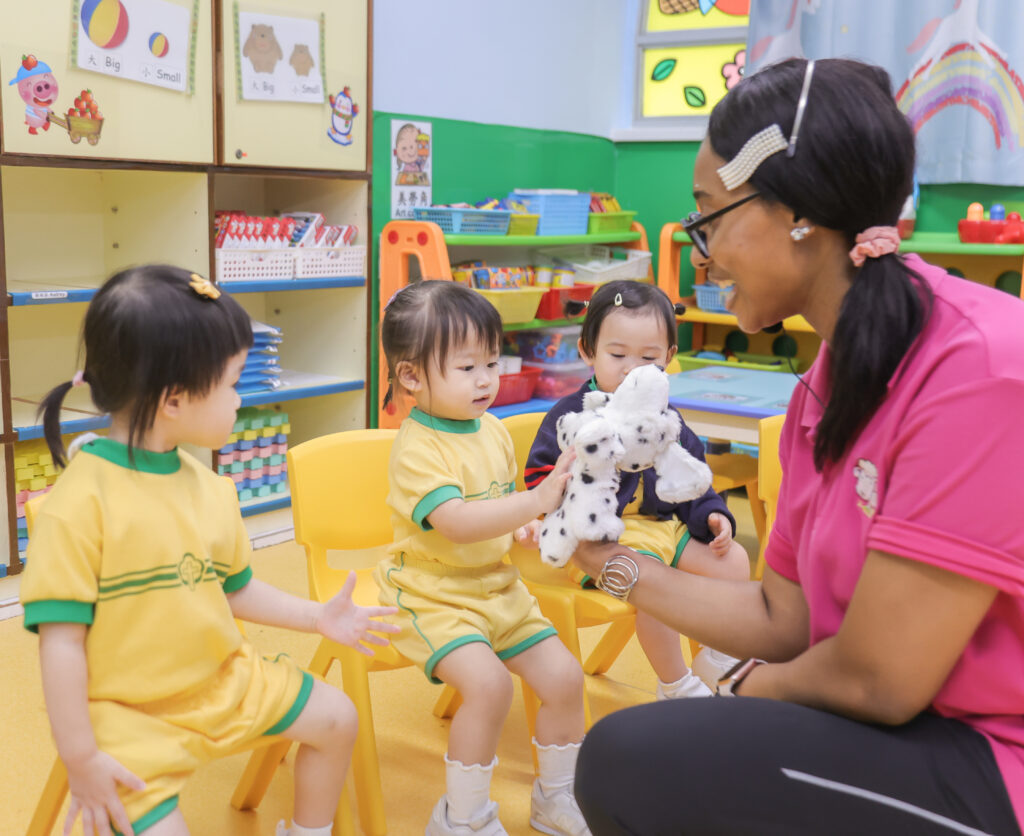





With spiritual education as the “core”, thematic teaching as the “backbone”, bilingual teaching as the “longitude”, book reading as the “latitude” and free playing as the “arteries and veins”, we developed a curriculum that is consisted of the three parts of “thematic teaching”, “character education” and “thinking and action”. The six learning areas of language, early childhood mathematics, self and society, nature and living, physical fitness and health and arts and creativity are included in this curriculum that is strategize with story, art creation, songs and dances, science experiment and physical game, in order to bring a balanced curriculum and development to children.
(1) Bilingual teaching:
We have always been committed to providing quality education services. Not only arranging qualified teaching staff (with a diploma in Early Childhood Teaching or above) for each bilingual class (no more than 28 students) as the head teacher, we also hire an additional foreign teacher who specializes in teaching English and work together with a multi-class teacher system to provide more adequate care, so that every child can learn from pleasure.
Each foreign teacher only teaches in one class at the same time and will not teach in other classes. The school will add 7 foreign teachers to teach, hoping to build a richer English language scene.
Native-speaking English teachers use lively and life-oriented teaching methods to teach children English phonics, vocabulary, nursery rhymes, phrases and stories in a pleasant way, and cultivate their interest in English and usage of the language. In addition to the daily English lessons, native-speaking English teachers also participate in all types of school activities to provide children with more opportunities of language interaction and establish an English learning environment.

(2) The Boys’ Brigade, Hong Kong – Anchor Lamb:
As the uniformed group of the school, the Anchor Lamb provides an adequate program of the Bible for children to learn about emotion, self-care, social and spiritual maturation, which will allow them to adapt school life more easily and also benefit the parent’s service development.
(3) “Listen to My Story” Book reading scheme:
As we pay attention to cultivating children’s interest and ability to reading, the scheme may greatly benefit children’s reading efficiency. It encourages children to read aloud stories to others for a few times during the week, so as to enhance children’s self-confidence, enrich their oral expression ability and usage of vocabulary through a delightful time of reading.
(4) Free playing:
By returning the “right to play” to children, they shall learn freely, self-consciously and proactively under this enjoyable environment to become the decision maker of the “game”, the possession of the materials and the creator of the surroundings. Self-taught playing of low events will provide experience to children, lead them to construct and express new ideas, solve problems, set rules and continuously challenge themselves, in order to reach their greatest potential. Children will also be guided by teachers to share, record and review their games, so as to erect their next learning ladder by reshaping experience, organizing and consolidating the newly gained knowledge and skills.
(5) Diverse teaching approaches:
Diverse teaching approaches (thematic learning, project learning and bilingual learning) will inspire children to explore the world, cultivate their love and ability to learning hence prepare them to face the future life.
(6) Examine and assessment:
With “focal assessment” and “continuous assessment” being constructed in our evaluation policy, we record children’s course of growth through both collective activities and observation to individuals. The “focal assessment” is specifically praised as a successful approach to focus on particular children’s development aspects by the Education Bureau.
